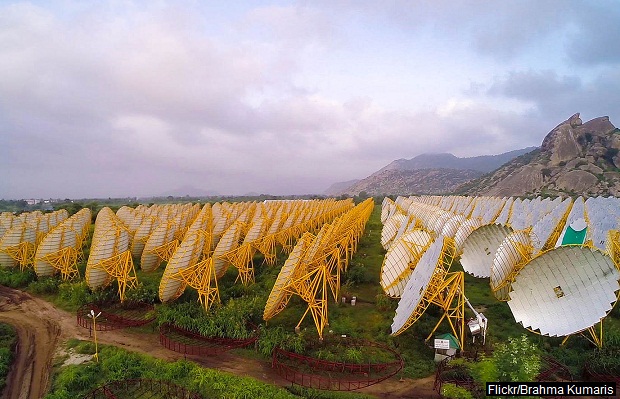India To Be World’s 4th Largest Renewables Consumer By 2030
Over the next 14 years, India is on course to become the world’s fourth-largest consumer of renewable energy, after China, United States and European Union, predicts the International Renewable Energy Agency’s (IRENA) report Road Map For A Renewable Energy Future, 2016 (REmap).
Renewable energy will account for 40% (two-fifths) of power generation in India by 2030, if global renewable energy supplies double, said the report released today.
India has embarked on a fast-track renewable-energy mission under the National Democratic Alliance government, particularly solar energy.
Thus far, India has financed less than $10 billion per year of renewable power projects. With renewable energy share doubling by 2030, India would need investments worth $60 billion per year for deploying REmap Options—which means deploying additional renewable energy capacity by 2030 above those envisaged by today's policies.
Solar and wind energy projects in India are expected to attract investments of $20 billion each year from the coming fiscal until 2018-19, according to the Indian Renewable Energy Development Agency.
Currently, India ranks seventh in terms of installed renewable capacity with 31 GW in 2014, according to the Renewable Energy Policy Network For 21st Century’s (REN21's) Renewables 2015 Global Status Report.
Installed renewable capacity in India grew 25%, from 31.7 giga watts (GW) in March 2014, to 39.5 GW in January 2016. Similarly, installed solar-power capacity doubled from 2.6 GW to 5.2 GW over the same period.
India’s renewable energy push is echoed around the world
Renewable-energy investments in India more than doubled, from $4.9 billion in 2006 to $10.5 billion in 2015, according to this Bloomberg report.
The world can save up to $4.2 trillion annually by 2030--15 times more than the cost--by doubling the share of renewables from just over 18% today to 36% by 2030, the IRENA report said.
China, United States, India, Brazil, and Russian Federation will account for over half of the total global renewable energy use in 2030 implementing REmap Options, the report mentions.
It also predicts that, if REmap options (60% of the world’s renewable energy potential that can be achieved by implementing existing government plans) are deployed in all sectors, the top five consumers of renewable energy in 2030 would be China (20%), United States (15%), European Union (14%), India (9%) and Brazil (7%).
A six-fold jump in annual renewables share is required, from 0.17% per year, as observed in recent years, to 1% per year till 2030, to achieve this target, the report said. It would cost $290 billion per year to double renewable-energy share by 2030.
Renewable-energy share of the world’s energy mix will reach 21% by 2030, from its present 18%, according to existing national energy plans.
The IRENA report points out that doubling the global renewable share does not imply a doubling in every country. Implementation of all REmap options by 2030 would increase the renewable share between 20% and 70% in most countries.
The vast, global benefits of renewables
The report says that doubling the share of renewables can:
- Limit average global temperature rise to 2°C above pre-industrial levels (when coupled with energy efficiency).
- Avoid up to 12 giga-tonne of additional CO2 emissions per year in 2030, five times more than current national reduction targets.
- Provide 24.4 million jobs in renewables by 2030, compared to 9.2 million in 2014.
- Boost global Gross Domestic Product (GDP) by up to $1.3 trillion.
Implementing REmap options will need investments of $770 billion per year, on average, between 2016 and 2030, a 9% increase per year from 2015 levels, reaching US $1.3 trillion in 2030.
China reported an almost 10-fold increase (861%) over the last ten years in renewables, followed by Latin America, India (114%) and US (62%).
The year 2015 was a record year for renewable energy installations world-wide, with 64 GW of wind and 57 GW of solar PV commissioned, an increase of nearly 30% over 2014.
Renewable Power Capacity (GW): Top Seven Countries, 2014
Source: Renewables 2015 Global Status Report; Figures in Gigawatts (GW); Does not include hydropower
India accounted for 5% of the global renewable-power capacity (657 GW) in 2014.
(Mallapur is an analyst with IndiaSpend.)
We welcome feedback. Please write to respond@indiaspend.org. We reserve the right to edit responses for language and grammar.
__________________________________________________________________
Liked this story? Indiaspend.org is a non-profit, and we depend on readers like you to drive our public-interest journalism efforts. Donate Rs 500; Rs 1,000, Rs 2,000.



